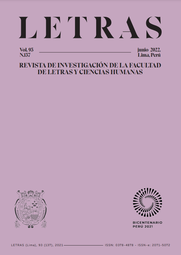Late Modern Characteristics in The Handmaid’s Tale
Abstract
This article proposes a study of The Handmaid’s Tale (Margaret Atwood, 1985) within late modernity by examining three characteristics: theocracy, patriarchy, and internal dialogue. To fulfill the objective of the article, the novel will be contrasted with the two characteristics that Zygmunt Bauman attributes to this late modernity in which, although there has been a change with respect to the first modernity, there is no break but a continuation. The first characteristic consists in the loss of the telos of the political community. The other characteristic that Bauman adheres to late modernity is a change in the political perspective in which it is renounced that it is society as a whole that attempts a social change and the self-assertion of the individual is privileged. This work is justified because a good part of the previous works that also study this novel are prior to the appearance of the self-denominated Islamic State and the push of populist movements in the West; and they also predate the Me Too movement. This novel allows us to adapt the categories of analysis to a different historical moment from the one that signed several of the novels of the dystopian canon.Downloads
Métricas alternativas
References
Alderman, N. (2017, 25 de marzo). Dystopian dreams: how feminist science fiction predicted the future. The Guardian. https://www.theguardian.com/books/2017/mar/25/dystopian-dreams-how-feminist-science-fiction-predicted-the-future
Atwood, M. (2017a, 10 de marzo). Margaret Atwood on What “The Handmaid’s Tale” Means in the Age of Trump. The New York Times. https://www.nytimes.com/2017/03/10/books/review/margaret-atwood-handmaids-tale-age-of-trump.html?_r=0
Atwood, M. (2017b [1985]). The Handmaid’s Tale. Vintage.
Bauman, Z. (2004). Modernidad líquida (3.ª reimpresión). Fondo de Cultura Económica.
Bauman, Z. (2017). Retrotopía. Barcelona.
Bloom, H. (2001). Modern critical interpretations of The Handmaid’s Tale. Chelsea House Publishers.
Bloom, H. (2003). Margaret Atwood’s the Handmaid’s Tale. Chelsea House Publishers.
Burgess, A. (1973). The clockwork condition (Publicado de nuevo en la edición de 4-11 de enero de 2012). The New Yorker. https://www.newyorker.com/magazine/2012/06/04/the-clockwork-condition
Fraser, N. y Nicholson L. (1988). Social Criticism without Philosophy: An Encounter between Feminism and Postmodernism. Theory, Culture, Society, 5, 373-394. https://doi.org/10.1177/0263276488005002009
Frye, N. (1965). Varieties of Literary Utopias. Daedalus, 94(2), 323-347.
Howells, C. A. (2006). The Cambridge Companion to Margaret Atwood. Cambridge University Press. https://doi.org/10.1017/CCOL0521839661
Huntington, S. (1996). The clash of civilizations and the remaking of World order. Simon & Schuster.
Jones, S. (2017, 20 de abril). The Handmaid’s Tale Is a Warning to Conservative Women. The New Republic. https://newrepublic.com/article/141674/handmaids-tale-hulu-warning-conservative-women.
Konner, M. (2015). Women after All. Sex, Evolution and the end of Male Supremacy. W. W. Norton and Company.
Kumar, K. (2010). The Ends of Utopia. New Literary History, 41(3) 549-569.
Macpherson, H. S. (2010). The Cambridge introduction to Margaret Atwood. Cambridge University Press. https://doi.org/10.1017/CBO9780511781018
Mead, R. (2017, 17 de abril). Margaret Atwood, the prophet of dystopia. The New Yorker. http://www.newyorker.com/magazine/2017/04/17/margaret-atwood-the-prophet-of-dystopia?mbid=amp_tw
Miller, B. y Moss, E. (Productores ejecutivos). (2017-2021). El cuento de la criada [serie de televisión]. Daniel Wilson Productions, Inc.; The Littlefield Company; White Oak Pictures; MGM Television.
Stein, K. (1991). Margaret Atwood’s The Handmaid’s Tale: Scheherazade in Dystopia. University of Toronto Quarterly, 61(2) 269-279. https://doi.org/10.3138/utq.61.2.269
Tennant, C. (2019). Religion in The Handmaid’s Tale. A brief guide. Mineápolis: Fortress Press. https://doi.org/10.2307/j.ctvcb5bp1
Tolan, F. (2007). Margaret Atwood: Feminism and Fiction. Ámsterdam, Nueva York: Rodopi. https://doi.org/10.1163/9789401204545
Weigel, M. (2017, 26 de abril). We live in the reproductive dystopia of The handmaid’s tale. The New Yorker. http://www.newyorker.com/books/page-turner/we-live-in-the-reproductive-dystopia-of-the-handmaids-tale?mbid=social_twitter
White, H. (2009 [1993]). Francis Bacon. En J. Cropsey y L. Strauss (Comps.), Historia de la filosofía política (6.ª reimpresión) (pp. 350-367). Fondo de Cultura Económica.
Whitehead, A. L. y Perry, S. L. (2020). Taking America Back for God: Christian nationalism in the United States. Oxford University Press. https://doi.org/10.1093/oso/9780190057886.001.0001
Copyright (c) 2022 Letras (Lima)

This work is licensed under a Creative Commons Attribution 4.0 International License.
Este obra está bajo una licencia de Creative Commons Reconocimiento 4.0 Internacional



















